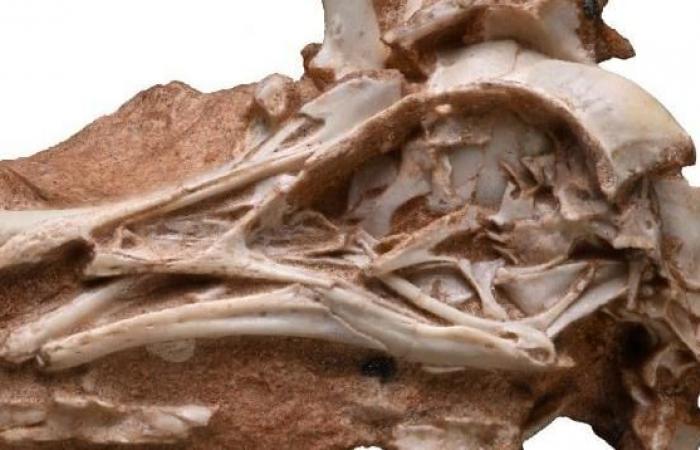What is the link between the starling and the winged dinosaur Archeopteryx? Named Navaornis hestiae and discovered in Brazil, a fossil approximately 80 million years old sheds light on the evolution of birds in the animal kingdom, according to a study published Wednesday in Nature.
The centerpiece of the discovery is a small skull less than three centimeters long, including the beak, remarkably preserved. It was discovered in 2016 in a small quarry in the state of São Paulo in Brazil, whose fossils are concentrated in a layer less than 50 centimeters thick.
The discovery place Navaorni’s hestia halfway between Archæopteryx150 million years old, and modern birds, whose origin dates back about 75 million years.
>> Holotype of Navaorni’s hestia:
The exceptional preservation of the small skull made it possible to reconstruct its geometry. It turns out to be similar to that of current birds, whose genus crow to which, for example, the crow belongs.
A brain very similar to that of birds living today
A cutting-edge scanning technique then allowed a reconstruction of the fossil’s brain, making it, according to its discoverers, a “Rosetta stone” to better understand the evolution of the bird brain.
External content
This external content cannot be displayed because it may collect personal data. To view this content you must authorize the category Services Tiers.
Accept More info
That ofArchæopteryx “was much more similar to that of dinosaurs” which did not fly, explains to AFP Professor Daniel Field, at the Department of Earth Sciences at the University of Cambridge, who supervised the study. “Relatively small in relation to its body”, unlike that of modern birds, it was also poorly developed in key regions for cognition and flight, specifies this paleontologist.
“The structure of the brain Navaornis is almost exactly intermediate between that ofArchæopteryx and that of modern birds”, estimates Dr. Guillermo Navalón, co-author of thestudyquoted in a Cambridge press release. Relative to the size of its body, the fossil’s brain was “much larger” than that ofArchæopteryxcontinues Prof. Field, and “very similar to that of birds living today”.
In contrast, its cerebellum, which plays an essential role in controlling flight in modern birds, was apparently less developed.
A real flying skill
However, the anatomy of Navaornis and features of the plumage and soft tissues of related birds, suggest true flight skill. What perhaps explains the presence in its inner ear of a “gigantic” vestibular apparatus, linked to balance, and “much larger than that of modern birds”, according to Guillermo Navalón.
“It seems very plausible” that this characteristic acted as a compensatory mechanism “allowing Navaornis to navigate in the air”, adds Daniel Field.
His study suggests that with a larger and more complex brain, the animal also had an advantage in evolving in a hostile environment or finding food.
External content
This external content cannot be displayed because it may collect personal data. To view this content you must authorize the category Social networks.
Accept More info
To find out more, the research team has high hopes for new discoveries at the site where the remains of Navaornis saw the light of day again.
It brings together fossils from the Late Cretaceous, a geological period which ended 65 million years ago with a mass extinction of species and in particular that of all non-avian, flightless dinosaurs.
With a surface area of only six square meters, the site is “small but full of vertebrate fossils”, according to Professor Field, with the potential to reveal “interesting new information on the biology of birds in the Mesozoic era”. . Tens of millions of years ago, this location was likely a dry area with slow-flowing streams, which allowed for the exquisite preservation of the fossil.
>> Read also: Fossilized fish heart sheds light on vertebrate evolution
External content
This external content cannot be displayed because it may collect personal data. To view this content you must authorize the category Infographics.
Accept More info
shoes, ebz et l’ats







